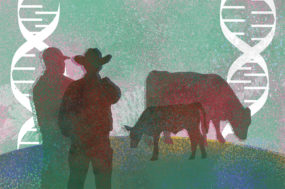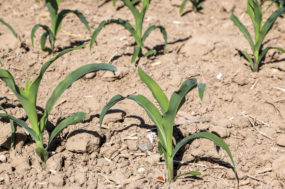Structural change has been indicated in the monthly Cattle on Feed reports for over a year. Fewer and fewer cattle are being fed in feedlots with a one-time capacity of less than 1,000 head. Those farms often include cropping enterprises and have made adjustments caused by high crop prices and negative cattle feeding margins.
USDA's monthly Cattle on Feed report only includes feedlots with over 1,000 head capacity and those feedlots represent an increasing proportion of U.S. cattle being fed. A result has been that the report can show inventory and marketing numbers above a year ago, but steer and heifer slaughter does not increase proportionally, in fact slaughter has often posted year-on-year declines. Expectations that "more market ready cattle are ahead" have tended not to materialize.
Now, let's review the Cattle on Feed report recently released. For the first time in any month during the last two years the on-feed count was below a year ago. As of May 1, the year-on-year decline was 0.6 percent (65,000 head).
Marketings during April were larger than pre-report estimates (including those of the LMIC), as has often been the situation in recent months. Analysts expected marketings below a year ago (down about 1.5 percent), but producers reported to USDA numbers slightly above a year ago.
Marketings in the report historically track rather well with steer and heifer slaughter, after making adjustments for the number of Canadian animals imported directly for harvest. In fact, USDA figures put steer and heifer slaughter for the month of April at 4.5 percent below 2011's.
As expected, placements of cattle into feedlots were below a year ago during April, down 15 percent. The average of pre-report estimates indicated a 12 percent drop. The year-on-year decline was due to:
1. Large numbers forced into feedlots last year because of drought.
2. Huge red ink on feedlot closeouts and no opportunity in April to lock in anything close to a breakeven sales price for purchased feeder cattle using risk-management tools.
3. Shrinking cattle supplies. Head placed in all weight categories were below a year ago, with the lightweight category (under 600 lbs) down 20 percent.
What are the implications of the latest Cattle on Feed report? In terms of futures market prices for fed cattle, the lows have most likely already been set for this year. The June contract rebounded this past week.
As has been the case for some time now, steer and heifer slaughter will be smaller than a cursory view of the report indicates. Based on recent trends and the May 1 number of cattle on feed in the 1,000 head and larger feedlots at 1 percent below a year ago, steer and heifer slaughter in several coming months down at least 3 percent would be consistent.
The Markets
As futures market prices recently strengthened:
1. It became increasingly apparent that there was not a backlog of market ready fed cattle.
2. Cattle on Feed pre-report estimates were viewed as supportive.
3. Wholesale beef markets strengthened.
Cash fed cattle prices gained ground. Live slaughter steers were up $2.88 per hundredweight (cwt) for the week and were 14 percent above a year ago. The weekly average wholesale price of Choice beef (Boxed Beef) increased to the highest level since early March.
Yearling and calf prices were generally higher compared to the prior week, with sale volumes seasonally declining, and many auctions from Kansas north have ramped-down sales for the summer. Compared to a year ago, in Oklahoma calf prices (500 lbs to 600 lbs) were up fully 23 percent while yearlings (700 to 800 lbs) were up a more modest 16 percent.
Corn costs increased during the week as reports circulated of smaller South American crops due to drought and buying interest from the Chinese. For the week, corn prices at Omaha increased by 44 cents per bushel, but were 11 percent below a year ago. For the week, Distillers Dry Grains (DDGS) costs increased some. ![]()
—From In The Cattle Markets newsletter from North Dakota State University, Mississippi State University, American Farm Bureau Federation and Kansas State University. Jim Robb is the center director for the Livestock Marketing Information Center.
PHOTO
For the first time in any month during the last two years the on-feed count was below a year ago. As of May 1, the year-on-year decline was 0.6 percent (65,000 head). Staff photo.








